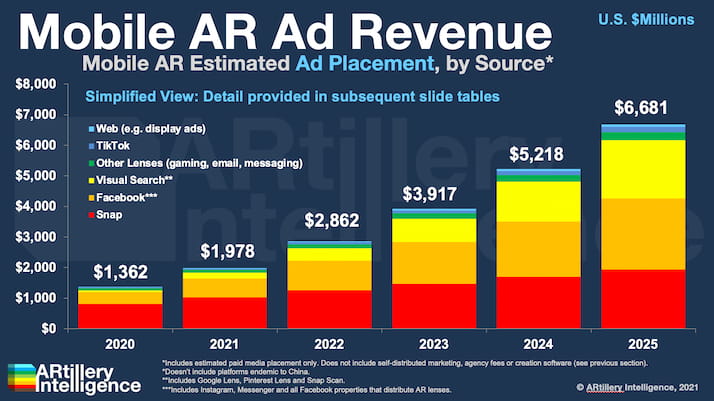
Like many analyst firms, market sizing is one of the ongoing practices of AR Insider’s research arm ARtillery Intelligence. A few times per year, it goes into isolation and buries itself deep in financial modeling. The latest such exercise zeroes in on mobile AR revenues.
This takes the insights and observations accumulated throughout the year and synthesizes them into hard numbers for spatial computing (see methodology and inclusions/exclusions). It’s all about an extensive forecast model coupled with rigor in assembling reliable inputs.
So what did the latest forecast uncover? At a high level, global mobile AR revenue is projected to grow from $6.87 billion in 2020 to $26.05 billion in 2025, a 30.5 percent CAGR. This sum consists of mobile AR consumer and enterprise spending and their revenue subsegments.
Drilling down, our latest Behind the Numbers installment looks specifically at mobile AR advertising revenues. How much is being spent on paid ad placement to amplify branded AR lenses? And which distribution channels are driving the most revenue to do so?
AR-Infused
Starting at the top, mobile AR ad placement will grow from an estimated U.S. $1.36 billion in 2020 to U.S. $6.68 billion in 2025, a 37.4 percent compound annual growth rate. This includes AR lens or visual search paid placement in the growing number of channels that offer it.
To specify that further, we’re talking about paid media portions of a given AR campaign. It includes paid distribution in places like Snapchat and Facebook, but excludes other costs such as experience creation software, agency fees or self-distributed lenses (e.g. brand apps).
So what’s driving this growth? As we examined in a recent report series, AR advertising adoption is driven by brand interest in immersive product demonstrations. This not only resonates with their creative sensibilities but shows a strong business case through high-performing ads.
In terms of formats, AR lenses lead today, such as selfie fodder from Snapchat and Facebook –including the increasingly AR-infused Instagram. Among social AR players today, Snap has the revenue lead due to greater levels of lens engagement and monetization per user.
But despite that early lead and camera-forward ethos. ARtillery projects Facebook to catch up to and surpass Snap in AR ad revenue by 2025. That’s due to its escalating total of AR users and its multi-app play that includes News Feed, Messenger, Portal and, again, Instagram.

Gaining Ground
Meanwhile, TikTok is the wild card, with rapidly growing usage but underdeveloped AR. And visual search — pointing your phone at products to identify them — will gain ground in later years. It will be driven by a practical and frequent use case that’s naturally monetizable (like web search).
But one question emerges from all of the above: what about web AR? The web’s low share of ad spend (see above) doesn’t reflect web AR’s opportunity. This goes back to the definitions for AR ad spend noted earlier: we’re talking about paid distribution portions of AR campaigns.
On that measure, the web — including formats like banner ads through mobile ad networks — hasn’t developed as much as lens-native platforms like Snapchat. But web AR still has ample revenue opportunity in experience-creation software and brands’ self-distribution channels.
Put another way, web AR operates through the mobile browser, but its promotion and distribution will happen in several channels other than paid banner ads on the web. We’re talking brand-owned channels such as product packaging, apps, print media, and other marketing vessels.
Lastly, what about Covid impact? Though advertising is a famously recession-prone category, AR ads could ultimately benefit as downturns cause advertisers to redeploy budget to emerging and performant formats. Throughout 2020, this exposed AR advertising to a larger demand base.
We’ll pause there and circle back in the next Behind the Numbers article to zero in on another AR revenue category…






